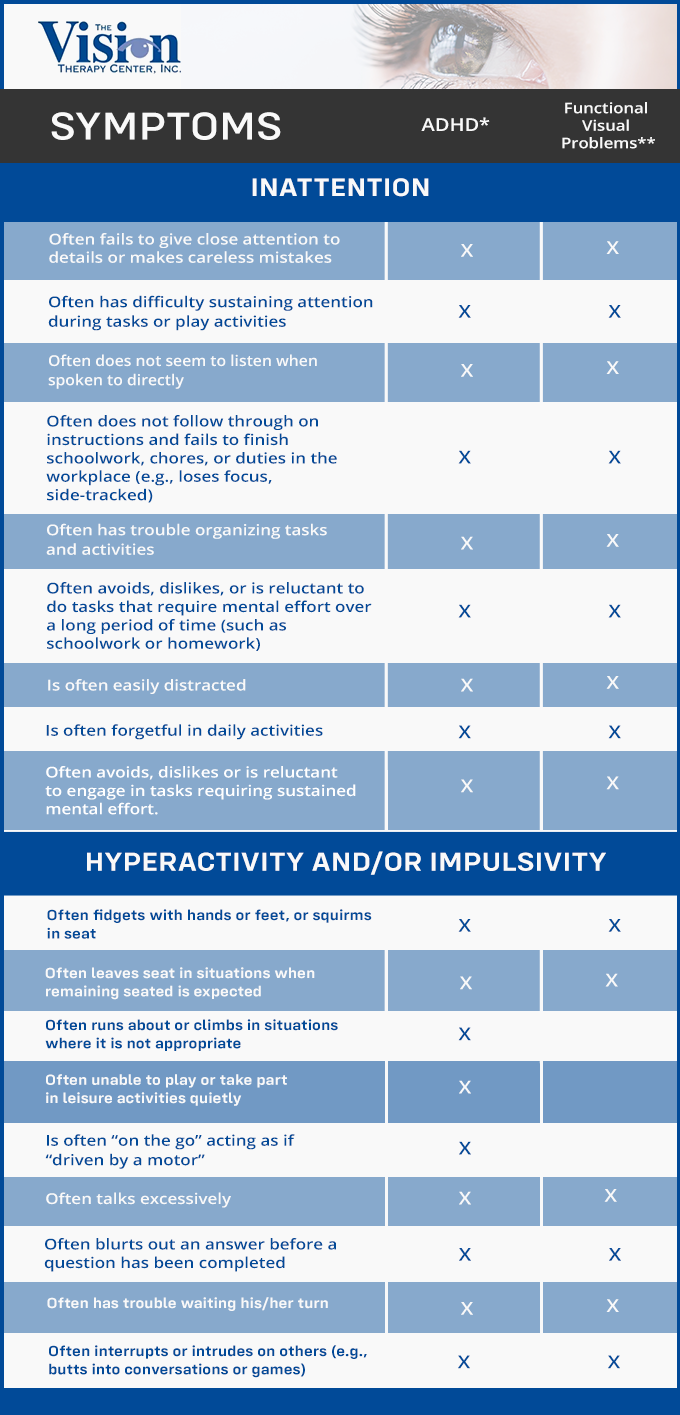By Dr. Kellye Knueppel
This post is sponsored by The Vision Therapy Center, which has offices in Brookfield, Fond du Lac, and Madison, Wisc.

If your child seems to have poor attention skills, especially in class, don’t be too quick to assume it’s an attention disorder. Symptoms of functional vision problems can closely resemble attention deficit hyperactivity disorder (ADHD).
In fact, at The Vision Therapy Center, where I practice as a developmental optometrist, I’ve had cases where parents have brought in their child diagnosed with ADHD, only to discover that many (or all) of the child’s symptoms could be attributed to a functional vision problem.
Below, I’ll describe functional vision, explain why problems with it can be confused with ADHD, and suggest what you as a parent can do if your child struggles with maintaining attention.
Understanding Functional Vision
Functional vision skills encompass how the entire visual system — the eyes, the brain, the visual pathways — works together to help a person interact with the environment.
More specifically, these skills include the following:
Eye teaming. In normal vision, this occurs when both eyes align to focus on the same point in space and work together in a precise and coordinated way.
Eye focusing. This involves the ability to see an object clearly and to shift focus between objects at different distances.
Eye movement. This includes the eyes’ ability to maintain fixation on a moving object through space, to move fixation from one object to another, and to sustain fixation on a stationary object.
Symptoms of Functional Vision Problems in Children
For a child, when the visual skills that enable good functional vision don’t operate properly, symptoms — and behaviors — like these can emerge:
1: Has difficulty paying attention in school.
A child with a functional vision problem can have trouble with one or more of the vision skills described above. This can make typical classroom tasks much more challenging and in some cases nearly impossible.
In turn, the child may grow frustrated and fatigued, become fidgety, stare off into space, or start talking to a nearby student. In other words, the vision problems can lead to inattention.
2: Has trouble with schoolwork and reading.
Difficulty with eye teaming (see above) makes it hard to see a line of text as single and clear when reading. That means the act of reading takes more effort than it should and results in varying degrees of visual discomfort.
Some children push through the discomfort and read at a slower rate. Others may simply stop trying and in the process appear to their teachers as if they simply can’t stay on task. But in reality, they’re just frustrated and don’t know how to ease the discomfort.
3: Doesn’t respond normally when spoken to directly.
A functional vision problem can negatively impact a child’s ability to process what is seen and integrate that with other senses being engaged.
For example, if a child is trying to focus on the words written on the whiteboard, they might not be able to process what a teacher has just said; they’re putting all their energy into understanding what’s on the board.
4: Makes careless mistakes and misses details.
A child with a functional vision problem often has a limited window of time in which to comfortably complete visual near work like reading, writing, and other homework.
As a result, the child may feel the need to rush so they can avoid the onset of symptoms like blurry vision, double vision, headaches, or eye strain. Understandably, this can result in poor attention to details and careless mistakes.

Be Aware of the Strong Similarities Between ADHD and Functional Vision Problems
In school, children with ADHD often have difficulty focusing. They may also fidget or squirm in their seat, appear careless in their work, and/or fail to follow through on instructions.
Sound familiar? As you learned above, functional vision problems in children can produce a similar set of symptoms. In fact, the overlap is so remarkable that I’ve compiled a chart comparing the symptoms side by side.
 Sources for chart:
Sources for chart:
*The Centers for Disease Control and Prevention’s shortened form of ADHD criteria based on the Diagnostic and Statistical Manual of Mental Disorders, Fifth Edition (DSM-5)
**American Optometric Association

How Can You Know for Certain?
A vision problem, ADHD, or possibly both? It’s actually impossible to tell without completing a Functional Vision Exam. If the exam reveals a functional vision problem, then we know for certain that it’s contributing to the difficulty with attention.
In fact, it’s critical that functional vision problems are identified because they can be treated with an individualized program of optometric vision therapy.
But we won’t know for certain how much a child’s functional vision problem is affecting attention until the program has been completed. If there are remaining symptoms, it will be easier to determine if they can be attributed to other factors, such as ADHD.
If you’d like to make a preliminary step, I suggest you take The Vision Therapy Center’s free online Vision Quiz.
And if you’re seriously concerned that your child’s ADHD-like symptoms could be the result of vision-related problems, schedule a Functional Vision Exam as soon as possible.
About the author: Dr. Kellye Knueppel is an award-winning developmental optometrist specializing in vision related learning problems, sports vision, and rehabilitative optometry. She is board certified in vision development as a Fellow of the College of Optometrists in Vision Development. Since opening The Vision Therapy Center in 1995, she has dedicated herself to helping people of all ages overcome their visual problems.









